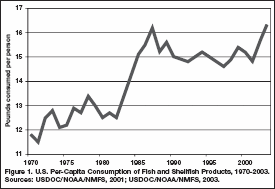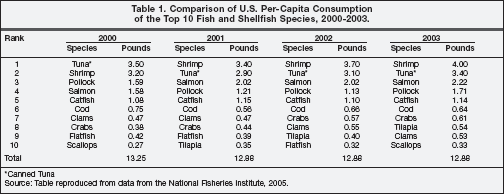
Abstract
Survey results identify characteristics and opinions of shrimp consumers and nonconsumers. Of a sample of 1,398 respondents to a nationwide mail survey on seafood consumption, 86% consumed shrimp, with an average shrimp consumer eating shrimp 4.4 times per month. Shrimp consumers were most likely to purchase seafood at restaurants and grocery stores.
Shrimp consumers primarily ate shrimp because of enjoyment of flavor. Additional attributes that shrimp consumers enjoyed included variety in diet, availability of fresh products, and health/nutrition. Price, lack of available fresh product, and lack of preparation knowledge were the top three reasons shrimp consumers did not eat more shrimp. Nonconsumers identified taste, smell, and texture as the three principle reasons why they did not eat shrimp. A small number of nonconsumers (9%) and consumers (3%) suggested that product safety concerns were a reason for not eating shrimp (or not eating shrimp more frequently).
Respondents were asked what factors would increase their shrimp consumption. Seventy-six percent of nonconsumers indicated that nothing would increase their consumption. Alternatively, 81% of shrimp consumers believed there were factors that would increase their consumption. The number-one method to increase shrimp consumption for consumers was lower shrimp prices.
Additional factors included coupons (to reduce cost), availability of fresh products, government safety inspections, and recipes. Survey results suggest there are opportunities to increase shrimp consumption in the U.S., especially with individuals who already purchase shrimp. According to the options presented in the survey, the primary catalyst to increase shrimp consumption is to decrease the price of the product and target shrimp consumers.
In contrast, it would be more challenging to attract nonconsumers of shrimp to the shrimp market. Most nonconsumers are unwilling to eat shrimp because of its taste, smell, and texture, which would be difficult, if not impossible, to change.
Introduction and Background
Fish and shellfish products are enjoyed by Americans, and consumption of these products has recently increased after a relatively flat consumption level during the 1990s (Figure 1). During the 1990s, shellfish products made up an increasingly greater share of the total amount of seafood consumed (Figure 2). Shellfish products include several animals, such as clams, crabs, crawfish, lobsters, mussels, oysters, scallops, and shrimp.
Overall per capita fresh and frozen shellfish consumption in the United States has increased from 3.4 pounds in 1989 to 5.7 pounds in 2003 (Figure 2). During the same time period, per capita consumption of shrimp has increased from an average of 2.3 pounds per year in 1989 to a record high of 4 pounds in 2003 (Figure 3). This is 25% of all seafood consumed and 66% of all shellfish products consumed in the U.S. In 2001, shrimp surpassed canned tuna for the first time as the most consumed seafood species in the U.S., and shrimp continued to be the highest consumed seafood product in 2002 and 2003 (Figure 4). Annual shrimp consumption steadily increased at a rate of 0.2 to 0.3 pounds per person from 2000 through 2003 (Table 1).

An increasing amount of shrimp consumed in the U.S. comes from imports. In 1986, imports supplied 67% of the U.S. shrimp consumed, and in 2003, imports provided 1.5 billion pounds (heads-off weight) or 88% of the total U.S. shrimp supply (Figure 5). In 2003, the top three countries supplying shrimp to the U.S. were Thailand, China, and Vietnam. In that year, these three countries provided 54% of the total shrimp imports into the U.S. However, their supply to the U.S. in 2004 declined due to the weak dollar and their interest in marketing shrimp to other countries (USDA/ERS, 2005).
In 2004, the U.S. Department of Commerce released findings from an antidumping investigation on certain frozen and canned warmwater shrimp from China, the Socialist Republic of Vietnam, Brazil, Ecuador, India, and Thailand. The result of these investigations indicated that producers/exporters from these countries sold frozen and canned warmwater shrimp in the U.S. below fair market value. Antidumping tariffs were put into place for certain frozen warmwater shrimp and prawns for these countries. However, the U.S. Department of Commerce has offered to send teams to India and Thailand to assess the status of the shrimp industry after the December 2004 tsunami to evaluate if the tariffs will remain in place for Thailand and India (USDC/IA, 2005). Tariffs and the weakened U.S. dollar may affect the amount and form of shrimp imports in 2005 and subsequent years.
The recent import statistics show frozen shrimp was the dominant item accounting for 76% of all shrimp product imports in 2004 (Figure 6). Fresh shrimp import quantities are small (<1%), and the majority of the supply comes from Thailand, China, India, and Vietnam. The third shrimp import category of prepared products (canned, cooked, etc.) is growing fast due to shrimp farmers and processors developing value-added products and U.S. firms looking to use these products in prepared meals, as well as retail and restaurant sales. In 1998, prepared products represented 13% of the total imports, while in 2004 they represented 23% of the total imports (USDA/ERS, 2005).
Shrimp farming in the U.S. occurs primarily in Texas but is small compared with total U.S. supply, which mainly comes from wild shrimp harvesting (4.8 million pounds grown in Texas represented 2% of the U.S. domestic production in 2000). A much larger portion of the total imported shrimp quantity is produced through aquaculture. Total world farmed-shrimp production has grown from 72.8 million pounds in 1975 (2.3% of world supply) to 1.72 billion pounds in 1998 (25% of world supply); 75- 85% of this cultured shrimp comes from Asia, and the remaining 20-25% is produced in Central and South America (Treece, 2000). U.S. shrimp landings in 2003 amounted to 323 million pounds valued at $441 million.
The Gulf of Mexico accounted for 256 million pounds ($365 million) or 79% of the national total. Among the Gulf states in 2003, shrimp landings were greatest in Louisiana with 125.7 million pounds and 49% of the total Gulf catch, followed by Texas (79.2 million pounds, 31% of total Gulf catch), Florida (west coast, 18.1 million pounds, 7%), Mississippi (17.5 million pounds, 7%), and Alabama (15.7 million pounds, 6%) (USDOC/NOAA/NMFS, 2005). The amount and value of shrimp landings have varied over time in Mississippi. Nonetheless, the wild shrimp harvesting/ processing industry contributes significantly to the local economies of coastal Mississippi and neighboring states in the Gulf of Mexico (Posadas, 2000a and 2000b). The pounds of shrimp processed in Mississippi from 1990 through 2003 have not varied as much as the total value of the shrimp processed in the state (Figure 7). This discrepancy is due to changing shrimp prices, which dramatically dropped in 2000.
Shrimp is a popular seafood in the U.S., and an increased understanding of why consumers purchase and consume shrimp products is important to producers, marketers, and consumers of this commodity. Regional and national shrimp consumption can be affected by factors that vary across geographical regions, ethnic groups, income levels, and nutritional perceptions. In 2001, Mississippi State University, with support from the Mississippi- Alabama Sea Grant and the United States Department of Agriculture Higher Education Program, administered a nationwide mail survey to U.S. residents on the topic of seafood consumption.
Information on consumer perceptions toward marine shrimp obtained from this survey is summarized in this bulletin. The results from the 2000-2001 survey described in this publication should be useful to the U.S. shrimping industry, governmental agencies, and seafood retailers/marketers for a variety of reasons, namely for effective marketing. Knowledge of shrimp consumer demographics, consumption frequency, and regional seafood preferences can help harvesters, buyers, and sellers determine more precisely their markets and potential market niches.
Additional issues addressed in this survey provide insights into shrimp consumers attitudes and preferences toward factors that affect consumption, such as seafood safety, aquacultured or farm-raised product, country of origin, product attributes, and other factors affecting consumption frequency.
CONCLUSIONS
The results of this survey can help to identify characteristics and opinions of shrimp consumers and nonconsumers that can be used to develop marketing segments and better understand consumer attitudes towards shrimp. Of a sample of 1,398 respondents to a nationwide mail survey on seafood consumption, 86% consumed shrimp at least occasionally. The average consumption rate of shrimp was 4.4 times per month among people who ate shrimp.
Consumers and nonconsumers appear to have significantly different reasons for consuming or not consuming shrimp. Targeting existing consumers for increased sales is called market penetration. Targeting nonconsumers for consumption is termed market development. This study gives some indication as to the challenges the shrimp industry faces pursuing both market penetration and development strategies.
For market penetration, the reasons given for eating shrimp (enjoyment of the flavor, variety to diet, and availability of fresh products) and the reasons for not consuming more shrimp (price, lack of availability of fresh product, lack of preparation knowledge) can be used in developing plans to increase shrimp sales. Consumers indicated a lower price would increase their frequency of consumption, but other factors, such as coupons, availability of fresh products, government safety inspection, and recipes also were indicated as factors that might increase consumption for at least 20% of consumers.
For market development, reasons given for not consuming shrimp (taste, texture and smell) must be overcome to increase the number of shrimp consumers. Nonconsumers listed flavor as the principal reason why they do not eat shrimp. Lack of preparation knowledge was also important. Overcoming the dislike of flavor attributes is a big challenge, and it may be less likely the industry can persuade nonconsumers to eat shrimp, as 76% of nonconsumers indicated nothing would increase their consumption of shrimp.
To continue reading this article, including graphs, click here (PDF)
June 2006


